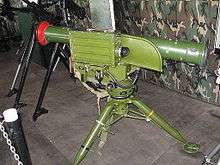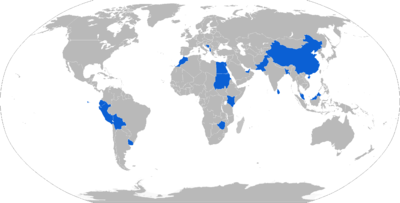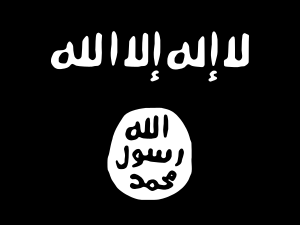HJ-8
The HJ-8 or Hongjian-8 (Chinese: 红箭-8; pinyin: Hóng Jiàn-8; lit.: 'Red Arrow-8') is a second generation tube-launched, optically tracked, wire-guided anti-tank missile system which was originally deployed by China's People's Liberation Army since the late 1980s.[3]
| HJ-8 | |
|---|---|
The HJ-8 on display | |
| Type | Anti-tank missile |
| Place of origin | China |
| Service history | |
| In service | 1985–present |
| Used by | See Operators |
| Wars | Yugoslav wars Sudanese conflict in South Kordofan and Blue Nile Syrian Civil War Iraqi Civil War (2014–2017) |
| Production history | |
| Designer | Research Institute 203 |
| Designed | 1970–1984 [1] |
| Manufacturer | NORINCO (Factory 282, Factory 5618)[1] Khan Research Laboratories (Pakistan)[2] |
| Produced | 1984–present |
| Variants | see variants |
| Specifications | |
| Mass | 25 kg |
| Length | 1,566 mm |
| Diameter | 120 mm |
| Engine | Solid-fuel rocket |
Operational range | 3,000–4,000 m |
| Maximum speed | 220 m/s |
Guidance system | SACLOS wire guidance |
Launch platform | Tripod, vehicle, aircraft |
Development
In 1970, China's armored corps first proposed to develop a successor to HJ-73 and this was later approved, designated as the AFT-8 or HJ-8. The missile was jointly developed by Research Institute 203 and 282nd Factory, but the program was interrupted by political turmoil. The key designers were Wang Xingzhi (王兴治) and Zhao Jiazheng (赵家铮), who developed the missile. Development was not completed until the early 1980s, after the end of the Great Proletarian Cultural Revolution. After receiving state certification, the missile entered mass-production in 1984. HJ-8 is an optically tracked, wire guided ATGM. A series of upgraded variants have been developed since.
HJ-8 and its variants are manufactured by NORINCO's Factory 282 (Jiangnan Machine Factory—江南机器厂), Factory 5618 (Hunan South China Photoelectricity Instrument Plant—湖南华南光电仪器厂) of China[1] and Khan Research Laboratories of Pakistan.[2]

Design
The HJ-8 series can be considered the Chinese equivalent of the US BGM-71 TOW and Franco-German MILAN / Euromissile HOT anti-tank missiles. HJ-8 is a tube-launched, optically tracked and wire-guided missile system armed with a HEAT anti-tank warhead. The HJ-8 is a combination many experts believe of three Western antitank missile systems obtained from nations in the Middle East and Asia that were then examined and reverse engineered and modified: the tripod from the US BGM-71 TOW; the tracker-control unit from the French/German MILAN; and the missile from the UK Swingfire.[4]
There are numerous improved models following the original HJ-8, designated HJ-8A to HJ-8H, each incorporating improved features over the previous model. HJ-8E entered service in mid-1990. The HJ-8E anti-tank missile weighs 24.5 kg, has a range of up to 4,000 m,[3] and can also defeat explosive reactive armour (ERA). The latest variant is the HJ-8H.
Designed to be both dependable and accurate, HJ-8 is now the standard anti-tank armament of the WZ-9, Mi-17, and Gazelle (replacing the original Euromissile HOT first carried) helicopter gunships of the PLA.[5]
Turret launch platform
A launching platform that can be installed on armoured fighting vehicles has been developed by Norinco for use as an HJ-8 launching platform, the SW-1 one-man turret. The all-steel welded SW-1 turret weighs 1,750 kg and can be installed on various tracked or wheeled vehicles. The turret is stated to be immune to 0.50 caliber armour-piercing rounds at close range (100 meters) and protection is further increased when add-on armour is installed. The turret can traverse 360 degrees and be elevated -40 to +60 degrees. The fire-control system, based on that of HJ-8H, is internally mounted.
The primary armament of SW-1 includes four HJ-8H ATGM, with two mounted in the rear location on each side of the turret. The secondary armament comprises a 30 mm main gun and a coaxial 0.30 caliber machine gun. A variety of ammo can be used and the maximum rate of fire of the main gun is around 6 rounds per second, and automatic fire can be selected at various rates. The 30-mm gun is claimed to be effective against ground targets up to 4 km away[6] and aerial targets at 2 km, while the HJ-8H missile is effective against ground targets at ranges of 4 km away,[7] and against low and slow aerial targets at the same range. A follow-on model that is remotely operated weighing 1.4 ton has completed its development and entered Chinese service, designed by the same designer, Wu Lixin (吴立辛). Like its predecessor, this unmanned model was also first tested by using HJ-73C ATGM. The unmanned version carries 160 rounds of 30 mm ammunition.
Variants
- HJ-8 – The original version. Claimed to be able to achieve a kill probability of 90%[8]
- HJ-8A – First upgrade of HJ-8 with greater penetration power, slightly larger than HJ-8, with range increased to 4 km.
- HJ-8B – A HJ-8 model specifically developed for helicopters, with greater penetration power and range increased to 5.3 km.
- HJ-8C – Specifically developed to defeat explosive reactive armour with a tandem-charge. From HJ-8C onward, all HJ-8 missiles can be carried by various platforms.
- HJ-8D – Upgraded variant with tandem charge.
- HJ-8E – Upgrade of HJ-8B/C with a new rocket motor with a range of up to 4 km, entered service in mid-1990. Fire-control system (FCS) is highly digitized and includes a thermal imaging system for all-weather day-night capability. The HJ-8E anti-tank missile weighs 24.5 kg, has a range of up to 4,000 m,[3] can also defeat explosive reactive armour (ERA).[9]
- HJ-8F – Variant with an anti bunker warhead.
- HJ-8FAE – Version featuring a thermobaric warhead.
- HJ-8L – A model with reduced overall weight, L meaning "light". Using feedback from the Bosnian War, HJ-8E was designed to meet the need of a lightweight ATGM that is just as capable as heavier models. HJ-8L can accommodate two missiles, one smaller with 3 km range and one larger with 4 km range. New microelectronics are used in the fire-control system and use of composite materials in the launching/storage system reduce weight to 22.5 kg, so that HJ-8L can be carried by a crew of two.
- HJ-8H – Upgraded HJ-8E; adopting the same fire-control system and lightweight launching/storage system of HJ-8L. Uses a new missile, capable of engaging ground targets 6 km away and low speed aerial targets such as helicopters 4 km away.
- HJ-8S – Variant with an anti ship warhead.
- Baktar-Shikan – Baktar-Shikan (Urdu: بکتر شکن "Armour Piercing") is a variant of HJ-8 that has been manufactured under license by Pakistan at Khan Research Laboratories since the late 1990s.[2][10][1] and had a successful first test in July 1997.[5] The missile and launch system can be quickly disassembled into four sub-units, each weighing less than 25 kg, making the system crew-portable. Baktar-Shikan is also mounted on Pakistani armoured personnel carriers (APCs) and a modified air-launched variant is used to arm the AH-1 Cobra helicopter gunships and other helicopters of the Pakistan Army Aviation wing. Pakistan also exports Baktar-Shikan. The export version is credited to destroy all currently known tank targets with a 90% hit and penetration probability at a distance of 3 km.[11] Baktar-Shikan has been exported to Bangladesh and Malaysia.[12] An indoor training simulator is also available with Baktar-Shikan. It is an exact replica of the weapon and is used to train operators by simulating various target speeds, ranges and angles. The target's movement parameters can be adapted to the progressive skill level of the operator under training.[13] An optional laser aiming device is also under development to increase accuracy at longer ranges.[12] According to SIPRI, between 1990 and 2015, Pakistan has produced 22,850 Baktar-Shikan missiles.[14]
- HJ-11 (AFT-11): development of HJ-8 with semi-active laser guidance, received a new designation HJ-11 because it is claimed to be the third generation anti-tank missile by Chinese.[15]
Combat use
Bosnia and Herzegovina
HJ-8 (possibly the Baktar-Shikan variant from Pakistan) units were supplied to Bosnian government forces in the early 1990s. Used by the Bosnian government forces against Bosnian Serb tanks during the mid-1990s.[1]
Sri Lanka
The Sri Lanka Army acquired at least 10 Baktar-Shikan units from Pakistan, during the civil conflict against the separatist Liberation Tigers of Tamil Eelam (LTTE). On at least one occasion, during the 2009 Battle of Mullaitivu the Army used these weapons against fast attack craft of the LTTE's Sea Tigers naval wing.[16]
Syria
Since June 2013, videos showing the use of the HJ-8 by Free Syrian Army rebels against Syrian Arab Army armor have surfaced and have been successful in destroying T-72 tanks.[17]
Iraq
Since December 2014, videos showing the use of the HJ-8 by the Peshmerga against Islamic State (ISIL) have surfaced. The HJ-8 systems might have been captured from ISIL stockpiles.[18][19]
Operators






















Specifications
- HJ-8
See also
- Related development
- Similar weapons
- Related lists
- List of anti-tank guided missiles
- List of missiles
References
- "Sino Defence's HJ-8 Page". Sino Defence. 2008-09-28. Archived from the original on 2009-01-23. Retrieved 2008-12-10.
- "Kahuta – Pakistan Special Weapons Facilities". GlobalSecurity.org. Archived from the original on 2009-02-14. Retrieved 2009-02-10.
- "Global Security's HJ-8 Page". Global Security. Archived from the original on 2008-12-13. Retrieved 2008-12-14.
- Jane's Weapon Systems 1988–1989 page 137
- "HJ-8". Federation of American Scientists. 1999-08-10. Archived from the original on 2009-04-02. Retrieved 2009-02-10.
- Jane's International Defense Review, 25 September 2008. This claimed range is likely exaggerated as the typical effective range of 30-mm automatic cannon is considerably less than four kilometers. The range claimed may be the maximum, as opposed to maximum effective, range of the weapon. By way of comparison, the M230 30-mm cannon has an effective range of 1.5 kilometers and a maximum range of 4.5 kilometers.
- "ATGWs still hit the spot: Anti-tank guided weapons". Pakistan Defence. Archived from the original on 13 September 2009. Retrieved 13 February 2015.
- Christopher Chant (January 1988). A Compendium of Armaments and Military Hardware (1st ed.). Routledge Kegan & Paul. p. 544. ISBN 978-0-7102-0720-3. Archived from the original on 15 May 2013. Retrieved 28 July 2012.
- "HJ-8E". Archived from the original on 2018-07-04.
- "Pakistan Army Inventory". Archived from the original on 2007-07-01. Retrieved 2008-12-10.
- "Anti Tank Guided Missile Weapon System, Baktar Shikan". Defence Export Promotion Organization. Archived from the original on 2009-02-02. Retrieved 2008-12-10.
- "KARACHI: POF, French firm sign deal for co-production: Artillery ammunition". November 21, 2006. Archived from the original on 27 September 2013. Retrieved 25 June 2013.
- Jane's Information Group. "IICS – Baktar Shikan ATGM Simulator (Pakistan), Land systems – Anti-armour". Retrieved 2010-05-12.
- SIPRI Arms Transfers Database. "Transfers and licensed production of major conventional weapons". Archived from the original on 2011-01-31. Retrieved 2011-04-01.
- "中国单兵导弹出口多国 又添新成员"红箭11"". Archived from the original on 25 October 2014. Retrieved 13 February 2015.
- https://www.youtube.com/watch?v=oFMtRCp4CbI
- Oryx. "A new weapon on the Syrian battlefield; The HJ-8". Oryx Blog. Archived from the original on 2 May 2014. Retrieved 13 February 2015.
- Beckhusen, Robert (25 October 2017). "What Destroyed This Abrams Tank? Possibly a Chinese-made missile". War is Boring. Archived from the original on 27 July 2018. Retrieved 27 July 2018.
- https://www.dw.com/downloads/41953510/weapons-of-the-islamic-state.pdf
- "Trade-Register-1971-2018.rft". Stockholm International Peace Research Institute. Retrieved 2019-04-21.
- "Archived copy" (PDF). Archived (PDF) from the original on 2018-08-02. Retrieved 2018-08-02.CS1 maint: archived copy as title (link)
- "Future Artillery Systems: 2016 Market Report" (PDF). Tidworth: Defence IQ. 2016. Archived from the original (PDF) on 22 January 2018. Retrieved 21 January 2017.
- "Small Arms Archive Detail Page for 7878". Small Arms Review.
- Small Arms Survey (2014). "Weapons tracing in Sudan and South Sudan" (PDF). Small Arms Survey 2014: Women and guns (PDF). Cambridge University Press. p. 227. Archived (PDF) from the original on 2016-10-14. Retrieved 2018-08-29.
- "Zona militar: Nuevos tanques para Venezuela". 4 September 2015. Archived from the original on 4 March 2016. Retrieved 5 September 2015.
- "Archived copy" (PDF). Archived from the original (PDF) on 2012-03-16. Retrieved 2011-09-04.CS1 maint: archived copy as title (link)
- US ARMY TRADOC G-2. Worldwide Equipment Guide, volume 1: ground systems. December 2011.
- Deagel.com. "HJ-8". Deagel.com. Archived from the original on 2009-09-18. Retrieved 2010-05-12.
External links
| Wikimedia Commons has media related to HJ-8. |